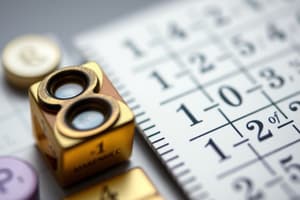Podcast
Questions and Answers
What is the base case for proving P(n) in the tiling problem?
What is the base case for proving P(n) in the tiling problem?
- Tiling a 2x1 puzzle
- Tiling a 1x1 puzzle
- No tiles needed for a 0x0 puzzle (correct)
- Tiling a 2x2 puzzle
What does Theorem B state about tiling with Bill?
What does Theorem B state about tiling with Bill?
- Bill is not required in a 2n x 2n puzzle.
- Bill can be placed anywhere in a 2n x 2n puzzle. (correct)
- Bill cannot be placed in any 2n x 2n puzzle.
- Bill can only be in the middle of the puzzle.
In the induction step, what is assumed to be true for the proof?
In the induction step, what is assumed to be true for the proof?
- Bill can be placed anywhere in 2n x 2n puzzles. (correct)
- Bill can only be tiled in corners.
- Tiling is impossible for odd dimensions.
- Tiling can only be done with 4 tiles.
What is a new idea introduced in the proof for the tiling problem?
What is a new idea introduced in the proof for the tiling problem?
Why is it important to prove that the number of squares is divisible by 3?
Why is it important to prove that the number of squares is divisible by 3?
What does Theorem 2 state about an infinite subset of a countably infinite set?
What does Theorem 2 state about an infinite subset of a countably infinite set?
Which proof technique involves proving that the negation of the conclusion leads to a contradiction?
Which proof technique involves proving that the negation of the conclusion leads to a contradiction?
What characterizes an even integer?
What characterizes an even integer?
Which of the following is an example of direct proof for a statement?
Which of the following is an example of direct proof for a statement?
In the proof regarding the closed interval [0,1], what is concluded about listing the real numbers?
In the proof regarding the closed interval [0,1], what is concluded about listing the real numbers?
According to the proofs presented, what can be said about the product of two odd integers?
According to the proofs presented, what can be said about the product of two odd integers?
How is the function g defined to show it is a bijection from N to an infinite subset B of a countably infinite set A?
How is the function g defined to show it is a bijection from N to an infinite subset B of a countably infinite set A?
What is the result when adding two even integers, according to the provided proofs?
What is the result when adding two even integers, according to the provided proofs?
What principle is used to prove statements in mathematical induction?
What principle is used to prove statements in mathematical induction?
Which of the following sequences does mathematical induction apply to?
Which of the following sequences does mathematical induction apply to?
In the inductive proof structure, which statement is correct about P(0)?
In the inductive proof structure, which statement is correct about P(0)?
Which statement correctly describes the induction step in mathematical induction?
Which statement correctly describes the induction step in mathematical induction?
What happens in the case of an integer n that is not prime according to the logic presented?
What happens in the case of an integer n that is not prime according to the logic presented?
Which of the following best describes the outcome of the induction process?
Which of the following best describes the outcome of the induction process?
What is the overall significance of the induction hypothesis in the proof process?
What is the overall significance of the induction hypothesis in the proof process?
How does mathematical induction illustrate its effectiveness?
How does mathematical induction illustrate its effectiveness?
What is the first step in the induction proof process?
What is the first step in the induction proof process?
In the induction step, what must be demonstrated?
In the induction step, what must be demonstrated?
Which of the following is NOT a valid component of a proof by induction?
Which of the following is NOT a valid component of a proof by induction?
Which case could be used to prove divisibility by 6 using induction?
Which case could be used to prove divisibility by 6 using induction?
What is the goal when proving an implication of the form 'If P, then Q'?
What is the goal when proving an implication of the form 'If P, then Q'?
Which proof method is used to prove that an integer is even if and only if its square is even?
Which proof method is used to prove that an integer is even if and only if its square is even?
What does UG stand for in the context of induction?
What does UG stand for in the context of induction?
In proving the contrapositive of 'If m is even, then m² is even,' which statement represents the contrapositive?
In proving the contrapositive of 'If m is even, then m² is even,' which statement represents the contrapositive?
For which integer n is the base case true in the context of proving an inequality?
For which integer n is the base case true in the context of proving an inequality?
In the context of the induction process, which is most critical to establish?
In the context of the induction process, which is most critical to establish?
Which of the following is a key characteristic of a proof by contradiction?
Which of the following is a key characteristic of a proof by contradiction?
What is the significance of the assumption P(i) in the induction step?
What is the significance of the assumption P(i) in the induction step?
What is the conclusion drawn from the proof of the statement that 'If √r is rational, then r is rational'?
What is the conclusion drawn from the proof of the statement that 'If √r is rational, then r is rational'?
In the context of proving that 2 is irrational, what is established by choosing integers m and n without common prime factors?
In the context of proving that 2 is irrational, what is established by choosing integers m and n without common prime factors?
Which of the following correctly represents a direct proof approach?
Which of the following correctly represents a direct proof approach?
To prove that 'If P, then Q' is equivalent to 'If not Q, then not P', what type of proof method is utilized?
To prove that 'If P, then Q' is equivalent to 'If not Q, then not P', what type of proof method is utilized?
Flashcards are hidden until you start studying
Study Notes
Countability
- A countably infinite set A ensures any infinite subset B of A is also countable.
- A bijection f: N → A allows for the construction of a bijection g: N → B through inductive reasoning.
Uncountable Sets
- The closed interval [0,1] is proven uncountable using a hypothetical bijection r: N → [0,1].
- A unique number exists that cannot be listed in the assumed bijection, demonstrating a contradiction.
Basic Proof Techniques
- Various logical proof strategies include direct proof, contrapositive, proof by contradiction, and proof by cases.
Direct Proofs
- An even integer n can be expressed as n = 2k; an odd integer n can be expressed as n = 2k + 1.
- The sum of two even numbers is shown to be even through algebraic manipulation.
- The product of two odd numbers results in an odd number, demonstrated stepwise.
Proving Implications
- To prove "If P, then Q," direct proof involves assuming P and logically showing Q follows.
- Proving the contrapositive involves demonstrating that "not Q implies not P."
Logical Equivalence
- An integer is even if and only if its square is even, needing proof in both directions for validation.
- Utilizing contrapositive reasoning allows alternate paths to establish logical equivalence.
Proof by Contradiction
- The irrationality of √2 is established by supposing it is rational and resulting in a contradiction.
- The prime factor consideration method concludes that every integer greater than 1 must possess a prime number.
Mathematical Induction
- Induction involves proving a base case (usually P(0)), then assuming P(n) is true to show P(n+1) must also be true.
- This creates a domino effect leading to the conclusion for all integers.
Induction Step Example
- When tasked to prove a general statement via induction, the process includes establishing a base case and logical progression to the next integer.
- Inductive reasoning is employed in various proofs related to divisibility and properties of integers.
Puzzle and Tiling Theorem
- A tiling puzzle demonstrates the intriguing application of induction to show how any 2n x 2n puzzle can be covered with L-shaped tiles while leaving one square empty for "Bill".
- The theorem reaffirms this capability when generalized, allowing placement of Bill in any square rather than just the center.
Studying That Suits You
Use AI to generate personalized quizzes and flashcards to suit your learning preferences.





